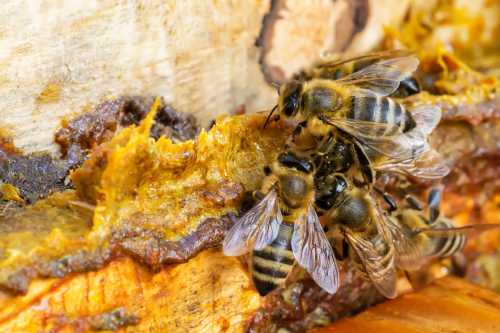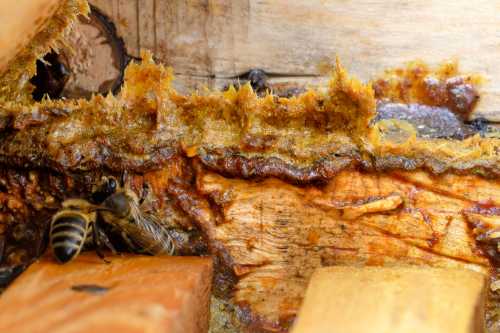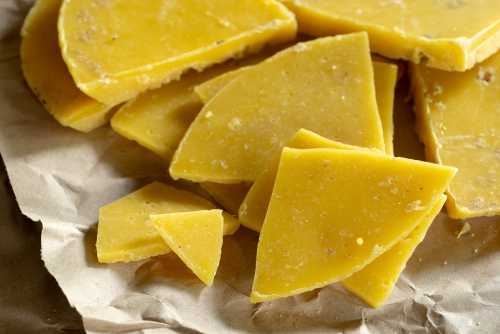Types Of Bee Propolis
Propolis, also known as 'bee glue' is a resinous mixture comprising resins gathered by honey bees from different parts of plants (e.g., buds and twigs) then mixed with beeswax and salivary enzymes (β-glucosidase, α/β-amylase, maltase, esterase, etc1.
Types Of Propolis
The properties of bee propolis differ, particularly depending on the plant source of the resin. Here we will compare 8 different types of propolis, plus four originating in Brazil (adapted from Magnavacca et al 20211).

1. Poplar propolis
Geographical origin:
Europe, North America,
temperate regions of Asia
(e.g., China).
Plant origin:
Populus (e.g. P. nigra L.)
Components and chemical markers:
Flavonoids, phenolic acids, and their esters – Pinocembrin, chrysin, galangin, pinobanksin, pinobanksin 3-acetate.
Notes: Flavinoids help protect against toxins.
2. Aspen propolis
Geographical origin:
Northern regions of Europe.
Plant origin:
Populus tremula L.
Components and chemical markers:
p-coumaric acid, ferulic acid, benzoic acid, benzyl p-coumarate, benzyl ferulate, glycerol esters of substituted cinnamic acids (phenolic glycerides).
Notes: Ferulic acid is sometimes found in anti-aging serums. Benzoic acid has anti-fungal properties.
3. Birch propolis
Geographical origin:
Northern region of Europe.
Plant origin:
Betula pendula Roth
Components and chemical markers:
Flavones and flavonols (different from those of poplar propolis).
Notes: Flavones are widely present in leaves, and are the primary pigments in white- and cream-colored flower. Epidemiological evidence suggests beneficial effects in cardiovascular and neuropathological diseases2.
4. Mediterranean propolis
Geographical origin:
Mediterranean region of Europe.
Plant origin:
Cupressus sempervirens L.
Components and chemical markers:
Diterpenes – isocupressic acid, pimaric acid, agathadiol, isoagatholal, totarol. N.B. Usually does not contain flavonoids and phenolic acids.
Notes: Diterpenes are known to be antimicrobial and anti-inflammatory3.
5. Canarian type propolis
Geographical origin:
Canary Islands.
Plant origin:
Unknown.
Components and chemical markers:
Furofuran lignanes
Notes: Furofuran lignanes exhibit a wide range of significant biological activities, including antioxidant, anti-inflammatory, cytotoxic, and antimicrobial activities4.
6. Pacific propolis
Geographical origin:
Taiwan, Okinawa, Hawaii, Indonesia.
Plant origin:
Macaranga tanarius (L.) Müll. Arg.
Components and chemical markers:
Prenylated flavanones (propolins).
Notes: Prenylated flavanones are a sub-class of flavonoids that demonstrate anti-oxidant activity6.
7. Mangifera indica propolis
Geographical origin:
Indonesia, Myanmar, Thailand.
Plant origin:
Mangifera indica L.
Components and chemical markers:
Phenolic lipids (cardanols, cardols, anacardic acid derivatives).
Notes: Phenolic lipids are fats & oils.
8. Caribbean propolis
Geographical origin:
Cuba, Venezuela.
Plant origin:
Clusia spp.
Components and chemical markers:
Polyprenylated benzophenones – Nemorosone, guttiferone E
9. Brazilian propolis - 4 types
Geographical origins:
Panama, Bahia State, São Paulo State, Alagoas State.
Plant origin:
Populus spp.;
Hyptis divaricata Pohl ex Benth;
Baccharis dracunculifolia DC,
Dalbergia ecastaphyllum(L.) Taub.
Components and chemical markers:
- Populus spp.: Mainly flavonoids – Chrysin, pinocembrin, pinobanksin, apigenin, galangin.
- Hyptis divaricata Pohl ex Benth: Prenylated benzophenones
- Baccharis dracunculifolia DC: Prenylated phenolic acids and flavonoids – Artepillin C, drupanin, p-coumaric acid, dihydrocinnamic acid.
- Dalbergia ecastaphyllum(L.) Taub: Isoflavans, pterocarpans, and chalcones – Vestitol, neovestitol, 7-O-methylvestitol, medicarpin, formononetin, daidzein.
Resources
1. Magnavacca, Andrea, Enrico Sangiovanni, Giorgio Racagni and Mario Dell’Agli. “The antiviral and immunomodulatory activities of propolis: An update and future perspectives for respiratory diseases.” Medicinal Research Reviews 42 (2021): 897 - 945.
2. Federico Dajas, in Bioactive Nutraceuticals and Dietary Supplements in Neurological and Brain Disease, 2015
4. Wen-Hui Xu, Ping Zhao, Meng Wang & Qian Liang (2019) Naturally occurring furofuran lignans: structural diversity and biological activities, Natural Product Research, 33:9, 1357-1373, DOI: 10.1080/14786419.2018.1474467
5. Santos CMM, Silva AMS. The Antioxidant Activity of Prenylflavonoids. Molecules. 2020 Feb 6;25(3):696. doi: 10.3390/molecules25030696. PMID: 32041233; PMCID: PMC7037609.
If you found this page helpful or interesting, I'd really be grateful if you would share it with others - if not this page, perhaps another, such as Gardening For Bees.
Thank you so much :) .

